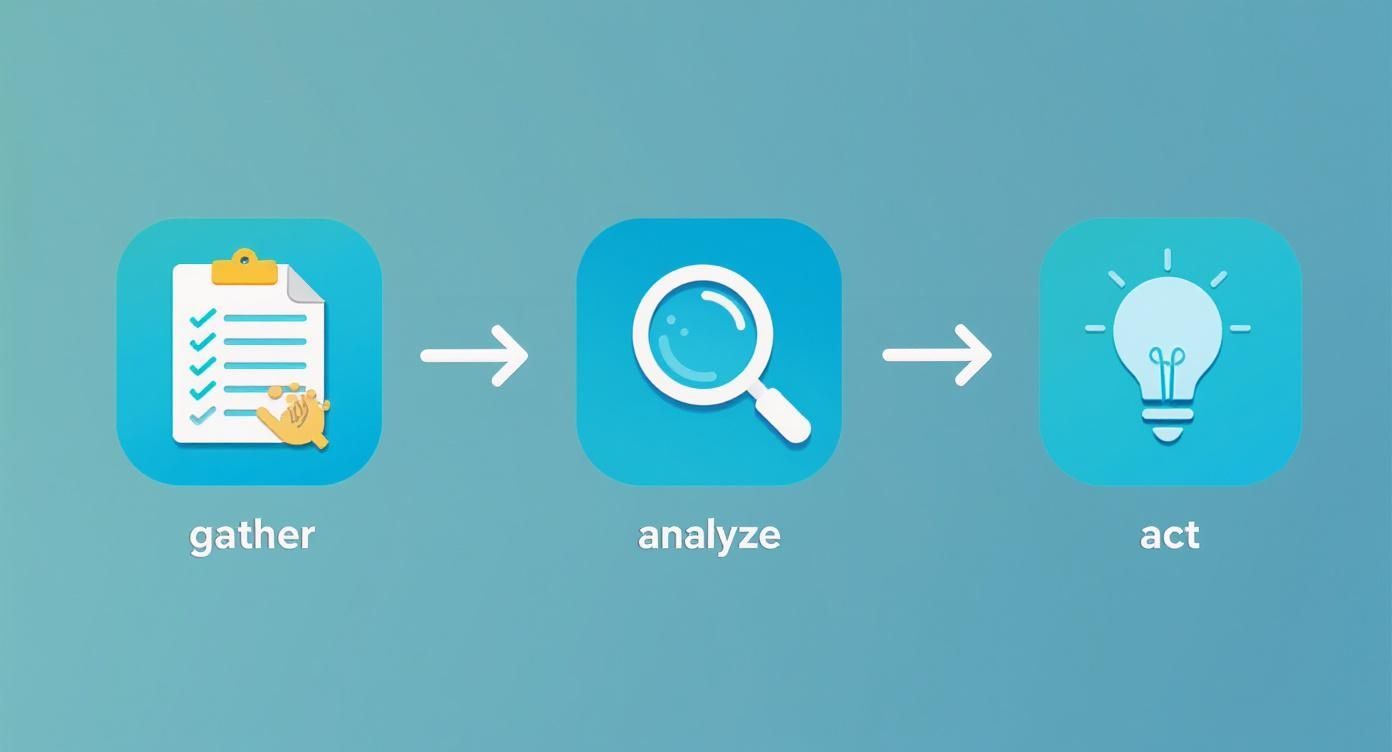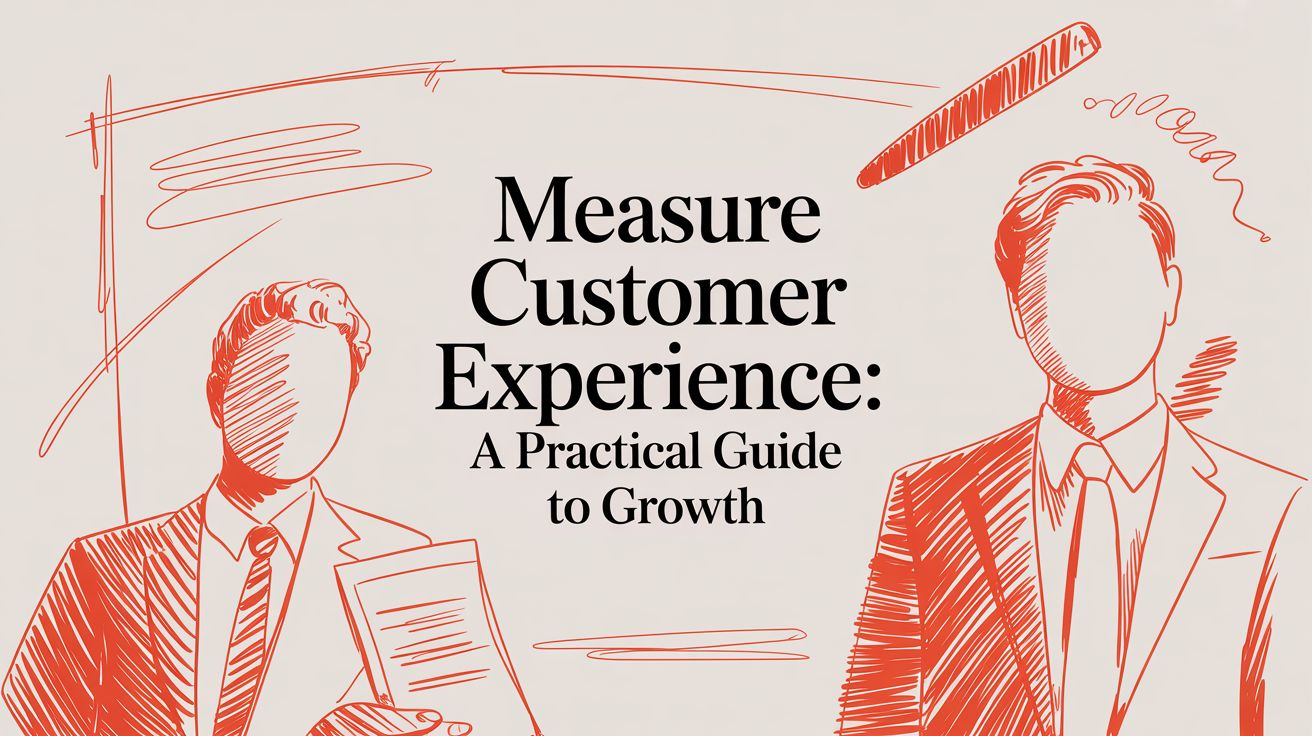To really get a handle on customer experience, you have to look past simple satisfaction scores. It’s about building a complete picture that captures how customers feel at every single touchpoint. The best way to do this is by blending relationship, transactional, and operational metrics to understand both long-term loyalty and what’s happening in the moment.
Why You Must Measure Customer Experience

Let’s get one thing straight: measuring customer experience (CX) isn’t just some ‘nice-to-have’ initiative. In today’s market, it’s the engine for sustainable growth and what truly sets you apart from the competition. Think of it as a direct line into what your customers are thinking and feeling, giving you the power to make business decisions that actually hit the mark.
If you’re not collecting data, you’re just guessing. That’s not just inefficient—it’s a huge risk. A single bad experience is all it takes to push a loyal customer right into the arms of your competitor. On the flip side, consistently great interactions build a loyal following that drives revenue and creates your best brand advocates.
The Real Cost of a Bad Experience
The stakes are higher than ever. It’s not enough to just have a fantastic product anymore; the experience that surrounds it is what really counts. The fallout from even one negative interaction is often immediate and surprisingly severe.
In fact, research shows that over 50% of customers will jump ship to a competitor after just one bad experience. That number isn’t just a statistic; it represents real, lost revenue and a tarnished reputation. You can find more eye-opening customer experience stats from sources like Zendesk.
Understanding customer perception isn’t just a reporting task—it’s an active strategy for survival and success. If you’re not measuring, you’re not managing.
Strategic Benefits of Measuring CX
When you get proactive about measuring customer experience, you unlock some serious strategic advantages that have a direct impact on your bottom line. You’re essentially turning customer feedback into a powerful business asset.
Here’s what that looks like in practice:
- Reduce Customer Churn: By spotting pain points before they become major problems, you can step in and fix things before a customer walks away for good.
- Increase Customer Loyalty: Great experiences create an emotional bond, turning casual buyers into dedicated fans who are far less sensitive to price.
- Drive Smarter Decisions: CX data gives you clear, unbiased evidence to guide everything from product development and marketing campaigns to service improvements.
- Boost Revenue: Not only do loyal customers spend more over time, but they also bring in new business through referrals, creating a powerful cycle of organic growth.
At the end of the day, measuring customer experience is really about listening to the market and then acting on what you hear. It’s the most reliable way to stay ahead of the curve.
Choosing the Right CX Metrics for Your Business

Feeling lost in a sea of acronyms like NPS, CSAT, and CES? You’re not alone. The truth is, you don’t need to track every metric under the sun to understand your customers. The real goal is to build a smart, balanced toolkit that tells a complete story.
The most effective CX programs don’t just pick one metric and call it a day. They strategically combine three different types: relationship, transactional, and operational metrics. Each one gives you a unique window into how your customers feel and where things are going right—or wrong.
Start with the Big Picture: Relationship Metrics
Relationship metrics are your 30,00-foot view. They measure the long-term health of your customer relationships and overall brand sentiment. Think of them as the pulse check for your brand, capturing the cumulative effect of every interaction a customer has had with you.
The most famous of these is the Net Promoter Score (NPS). It’s built on one powerful question: “On a scale of 0-10, how likely are you to recommend our company to a friend or colleague?” This simple query sorts your customers into Promoters, Passives, and Detractors, giving you a clear benchmark for loyalty.
Don’t mistake a high NPS score for a sign that everything is perfect. A loyal customer might still encounter friction. Relationship metrics are your starting point, not the final word.
Zoom in on Specific Moments with Transactional Metrics
While relationship metrics give you the big picture, transactional metrics are your magnifying glass. They zoom in on specific touchpoints to capture immediate feedback right after an important interaction, like a support call, a recent purchase, or a product demo.
This is where metrics like Customer Satisfaction (CSAT) and Customer Effort Score (CES) come into play.
CSAT is a classic for a reason. It asks a straightforward question like, “How satisfied were you with this interaction?” on a simple 1-5 scale. It’s perfect for getting a quick read on the success of a single event, like how well a support agent resolved a ticket.
CES asks a slightly different but crucial question: “How easy was it to handle your request?” This metric has become a massive predictor of loyalty. Research consistently shows that making things easy for customers is a huge driver of retention. An effortless experience often beats a “wow” moment.
Connect the Dots with Operational Metrics
Finally, we have operational metrics. These are the internal numbers—the gears turning behind the scenes—that directly shape how customers feel. Your customers will never see these KPIs, but they absolutely feel their impact.
Take First Contact Resolution (FCR), for instance. A low FCR rate—meaning customers have to call back multiple times to solve one problem—is a direct cause of high customer effort and rock-bottom satisfaction. Similarly, long Average Resolution Times (ART) just create frustration and broadcast inefficiency.
By tracking this internal data right alongside your CX metrics, you can draw a straight line from team performance to customer happiness. This connection is your secret weapon for making the business case for improvements. You can prove that boosting FCR by 10% leads to a measurable jump in CSAT, which justifies investing in better tools or training for your team.
To help you get started, here’s a simple framework that breaks down some of the most essential metrics. Think of this as your starter toolkit for building a comprehensive CX measurement program.
Key CX Metrics Framework
| Metric Type | Metric Name | What It Measures | Best Used For |
|---|---|---|---|
| Relationship | Net Promoter Score (NPS) | Overall customer loyalty and willingness to advocate for your brand. | Gauging long-term brand health and predicting organic growth. |
| Transactional | Customer Satisfaction (CSAT) | Immediate satisfaction following a specific interaction or event. | Getting quick feedback on touchpoints like support calls or purchases. |
| Transactional | Customer Effort Score (CES) | The ease with which a customer can resolve an issue or complete a task. | Identifying and eliminating friction points in the customer journey. |
| Operational | First Contact Resolution (FCR) | The percentage of support issues resolved in a single interaction. | Assessing the efficiency and effectiveness of your customer support team. |
Ultimately, the goal is to create a dashboard that gives you a holistic view. When you can see your relationship, transactional, and operational metrics side-by-side, you’ll stop guessing and start making data-driven decisions that genuinely improve the customer experience.
How to Collect Customer Feedback That Matters
Great metrics are only as good as the data you feed them. So, how do you get honest, useful feedback without driving your customers crazy with endless survey requests? To really measure customer experience, you need to think beyond the generic. It’s all about choosing the right channel, asking the right questions, and, most importantly, engaging at the perfect moment.
The best strategies don’t rely on a single method. Instead, they blend active and passive data collection. This gives you a complete picture, capturing both the feedback you ask for and the candid thoughts customers share on their own.
Actively Seeking Feedback
This is your direct line to the customer. Active methods are all about reaching out and asking for input. The trick is to be surgical about it—target specific interactions to get focused insights and make the request feel like a natural part of the conversation, not an interruption.
Some of the most common ways to do this include:
- Post-Purchase Surveys: Send an email a few days after a purchase. This is the perfect time to get feedback on the buying process itself and their initial impressions of the product.
- In-App Pop-Ups: If you run a SaaS platform or mobile app, these are fantastic. You can trigger a quick CES or CSAT survey right after a user completes a key action, like exporting a report or upgrading their plan.
- Email Surveys: This is your go-to for bigger-picture, relationship-level surveys like NPS. It gives customers the space to respond on their own time.
When you’re writing your questions, be careful to keep them neutral. Asking, “How much did you love our new feature?” will only get you biased answers. Instead, try something like, “How would you rate your experience with our new feature on a scale of 1 to 5?” It’s a small tweak that makes a huge difference in the quality of your data.
The secret to high response rates isn’t just asking—it’s asking at a moment of high engagement. A customer who just successfully resolved an issue is far more likely to provide feedback than one who hasn’t interacted with you in months.
Passively Listening for Insights
While asking directly is powerful, some of the most unfiltered, honest feedback comes from just listening. Passive collection means tuning into the channels where customers are already talking about you, unprompted.
Think of these as your feedback goldmines:
- Social Media Listening: Keep an eye on mentions, tags, and relevant hashtags on platforms like X (formerly Twitter), LinkedIn, and Instagram. What are people saying about you out in the open?
- Support Ticket Analysis: Your support conversations are an absolute treasure trove. Digging into trends can reveal recurring product bugs, confusing website navigation, or frequently requested features. For example, high-quality live chat support transcripts can pinpoint the exact moments where customers get stuck.
- Online Review Sites: Don’t forget about platforms like Google, Yelp, G2, or Capterra. These reviews often provide a detailed narrative of the entire customer journey, from the first touchpoint to the last.
When you combine these two approaches—actively asking and passively listening—you get a powerful, 360-degree view. The quantitative scores from your surveys tell you what is happening. The qualitative comments you find through passive listening reveal the crucial why behind those numbers. That combination is what turns data into a real strategy to measure customer experience and make improvements that actually matter.
From Raw Data to Actionable CX Insights
Collecting customer feedback is just the start. The real magic happens when you transform all those raw numbers and comments into a clear, actionable roadmap for your business. This is where we move beyond surface-level scores and really dig into the “why” behind the data to drive meaningful change.
The entire point is to translate what customers are telling you into concrete tasks for your product, marketing, and support teams. It’s not enough to spot a problem, like a dip in CSAT scores after a support call. You have to understand its root cause to truly fix it.
Uncovering Hidden Patterns Through Segmentation
Relying on a single, aggregate score can be incredibly misleading. A Net Promoter Score of +40 might look great on a slide, but it could be hiding major problems within a specific customer group. This is exactly why segmentation is your most powerful tool for analysis. When you slice your data, you start to uncover the hidden pain points that might be driving your most valuable customers away.
Try breaking down your feedback by a few key categories:
- Customer Persona or Tier: Are your enterprise clients having a completely different experience than your SMB users?
- Journey Stage: Is most of the negative feedback coming during onboarding, or does it pop up after six months of use?
- Product or Feature Usage: Do people who use Feature X consistently report higher satisfaction than everyone else?
- Demographics or Location: Are there regional nuances in how your service is perceived?
For instance, a SaaS company might discover that while their overall Customer Effort Score (CES) is solid, users on their “Pro” plan are struggling to integrate with a specific third-party tool. That’s a highly specific, actionable insight—far more useful than a vague, company-wide score. For more on this, our guide on how to optimize user experience offers some great strategies.
Performing a Root Cause Analysis
Once segmentation shines a spotlight on a problem, you need to figure out what’s actually causing it. A proper root cause analysis stops you from just treating the symptoms. If customers are complaining about long wait times, the wait is the symptom. The root cause could be anything from understaffing and inefficient internal processes to a new product bug that’s flooding your support queue.
To get to the bottom of it, you have to pair your quantitative scores with qualitative feedback. Dig into the open-ended survey comments, read the support ticket transcripts, and check the social media mentions tied to those low scores. The real story is always in the narrative.
“Actionable insight is the bridge between data and impact. Without it, you’re just admiring numbers on a dashboard instead of making your customers’ lives better.”
This simple flow shows how to methodically turn feedback into real improvements—you gather, analyze, and then act on what you’ve learned.

As the graphic shows, a great feedback program isn’t a one-and-done project. It’s a continuous cycle.
Creating Powerful Feedback Loops
The final—and most important—step is to close the loop. Insights are worthless if they just sit in a report on someone’s desktop. You have to build a system to get these findings into the hands of the teams who can actually do something about them.
This feedback loop needs to be a two-way street. Share a summary of key CX findings with your product team to help shape the next development sprint. Give your support team the latest trends from CES data so they can refine their training. These actions are more important than ever, as Forrester’s recent Customer Experience Index reveals that CX quality is actually declining globally. Even small improvements can slash customer churn and build loyalty, making it critical to focus your efforts. You can discover more about Forrester’s CX findings to see what’s happening across the industry.
Building a Culture That Lives and Breathes CX

Here’s a hard truth: measuring customer experience means nothing if the insights stay locked in a single department. For CX to really move the needle, it has to become part of your company’s DNA. It’s a shared mindset, a responsibility that everyone from the CEO to the newest hire feels personally invested in.
This is the leap from just collecting data to building a business that’s truly customer-obsessed.
The best place to start is by getting your CX data out in the open. Insights buried in a dense report don’t help anyone. You need simple, easy-to-read dashboards that put your key metrics on display for the entire company. When everyone can see how their work directly impacts CSAT or CES in real time, it builds a powerful sense of ownership.
Make CX a Shared Responsibility
To really embed this way of thinking, you have to make customer feedback impossible to ignore. A product developer needs to see the real comments about a feature they just shipped. The marketing team needs to understand how a campaign’s messaging is landing with actual customers.
This creates a constant feedback loop where every team sees its piece of the customer journey puzzle. Here’s how to make it happen:
- Share Raw Feedback: Don’t just share scores. Pipe unfiltered, verbatim customer comments directly into your team’s Slack or Teams channels. Hearing it in the customer’s own words is far more powerful.
- Start Meetings with a “Customer Moment”: Kick off team huddles by sharing a glowing review or walking through a frustrating support ticket. This grounds every discussion in the reality of your customers’ lives.
- Celebrate the Wins: When an employee goes above and beyond for a customer, make a big deal out of it. Public recognition reinforces the exact behaviors you want to see repeated across the company.
The real game-changer? Tying CX metrics directly to team performance goals. When improving the customer experience becomes a key result for every department, it stops being a vague idea and starts being a measurable priority for everyone.
Fueling Growth with Customer Insights
A customer-centric culture isn’t just about making people feel good; it’s about making smarter business decisions. We’re at a point where the expectation of a great experience is a massive driver for brand choice.
A recent Ipsos study found that 70% of customers worldwide pick brands based on this expectation alone. It’s a clear signal that people crave an emotional connection, not just a transaction. You can read more about these CX global insights to see just how critical this is.
This means the “voice of the customer” deserves a seat at the table during every major decision.
Are you getting consistent negative feedback about a specific step in your onboarding? That’s your sign to invest in better training or product tutorials. Seeing a flood of feature requests from your most loyal customers? That gives your product team a data-backed roadmap for their next sprint. You can even use what you learn from customer conversations to refine your outreach, like with these tips on automated direct messages.
When you truly live and breathe CX, you build a resilient business that grows for one simple reason: your customers are rooting for you to win.
Common Questions About Measuring CX
Diving into CX measurement often brings up more questions than answers. Getting a handle on these basics is the key to building a program that actually works. We’ll walk through some of the most common questions we hear from teams who are just getting started or looking to sharpen their CX strategy.
How Often Should We Measure Customer Experience?
The right timing really depends on what you’re trying to learn. There’s no single answer, so think of it as using different camera lenses for different shots.
For your big-picture, relationship-level metrics like Net Promoter Score (NPS), a quarterly or even semi-annual pulse check is usually plenty. This gives you enough time to see if your strategic initiatives are actually moving the needle on overall loyalty, without constantly bugging your customers.
Transactional feedback, on the other hand, needs to be immediate.
- Metrics like Customer Satisfaction (CSAT) and Customer Effort Score (CES) are most valuable when you capture them right after a specific event, like closing a support ticket or completing a purchase.
- Asking for feedback at that moment catches your customer’s raw, unfiltered feelings while the experience is still fresh. This gives you the kind of specific, actionable insight that’s gold for your frontline teams.
It’s all about striking a balance. You need enough data to see patterns, but not so much that you give your customers “survey fatigue.”
What Is the Difference Between Customer Experience and Customer Service?
This is a big one, and the distinction is critical. Think of customer service as a single, crucial piece of a much larger puzzle. It’s the direct help you provide when a customer has a problem or a question—it’s reactive and focused on a specific interaction.
Customer experience (CX) is the entire puzzle. It’s the sum of every single touchpoint a customer has with your brand, from the first ad they see, to the ease of navigating your website, to the quality of the product itself, and even their interaction with your social media.
A strong CX strategy ensures every one of these moments feels connected and positive. Amazing customer service is a non-negotiable part of that, but it’s just one chapter in the customer’s much longer story with your brand.
How Can a Small Business Start Measuring CX on a Budget?
You definitely don’t need a huge budget or a fancy suite of enterprise tools to get started. The trick is to start small and focus your efforts where they’ll have the most impact.
Here’s a simple, budget-friendly game plan:
- Start with Free Tools: You can easily capture feedback on one or two core metrics using free or low-cost survey tools. A simple CSAT survey sent after a purchase is a fantastic, high-value place to begin.
- Become a Social Listener: Pay close attention to your social media mentions and online reviews on platforms like Google. This is a free, unfiltered firehose of candid customer feedback.
- Keep It Simple: Don’t overcomplicate the analysis. A basic spreadsheet is often all you need to log comments, spot recurring themes, and identify your customers’ biggest pain points.
The goal at the beginning is just to open up a channel for listening. Once you start gathering this feedback and acting on it, you’ll build a powerful case for investing in more sophisticated tools down the road.
Ready to stop missing opportunities and start engaging every website visitor? LeadBlaze offers a 24/7 AI sales assistant that turns your traffic into qualified leads automatically. See how it works by starting your free 7-day trial.
